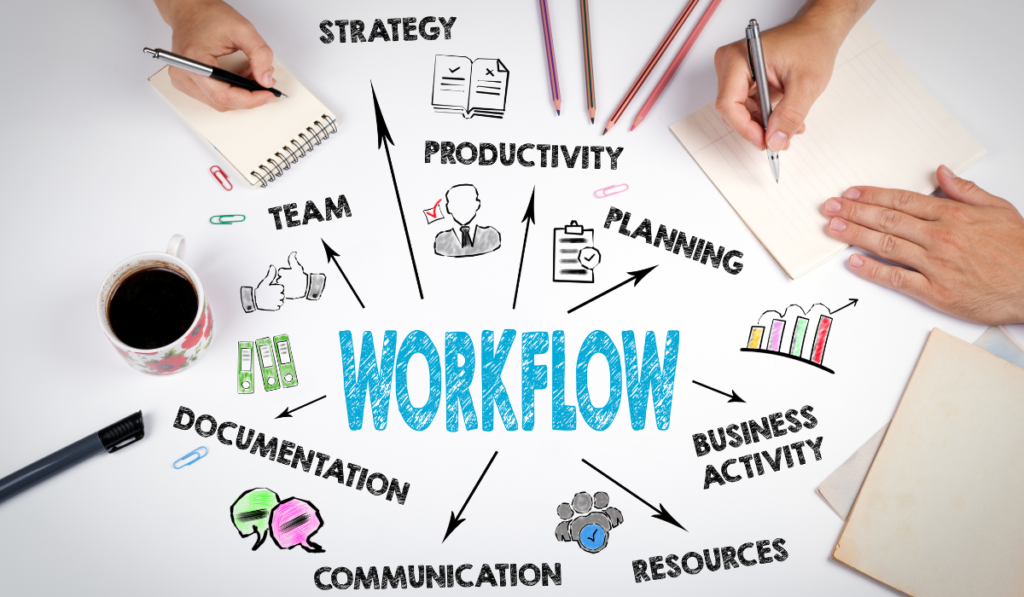A typical workday takes only eight hours, but about three are wasted on unnecessary or personal tasks. Those 15 hours are spent on non-productive tasks every week. Managing and improve the workflow efficiency procedures can help reduce time waste, even if you can only eliminate some. This way, employers can reduce the number of workflow issues they create. What steps can you take on the job to implement these changes? Enhancing workflow management and increasing productivity can be accomplished in eight ways.
Analyze Your Current Processes
Improving the workflow processes is the first step before doing anything else. It is important to seek feedback from your staff on the current procedures. It’s essential to figure out what’s working and what’s not. Based on the different roles in your organization, you need to analyze your current workflow. By optimizing these procedures, you will be able to make them more effective.
Prioritize Projects Based on Importance
To rank your current processes according to their importance to your overall goals, you must first understand what they are. Then, schedule these tasks and break each project down into parts. The idea is to prepare each task in a project according to the priority of completing the job. Therefore, it requires the correct tools to track the projects on which employees are working.
Implement Proper Training
It is vital to have the proper training processes in place to ensure employees do their jobs effectively. It is crucial to track and schedule employee training to do this correctly. As part of this process, employees will receive only the training they need by optimizing training procedures. Providing your employees with a thorough understanding of all safety procedures and proper methods will help them succeed.
Organize Efficiently
To keep workflows efficient, we must organize projects and schedules, so all parties clearly understand what is expected from them. The productivity of your employees needs to be tracked through processes. It would be the best choice if you also had schedules to keep track of an employee’s time spent on projects. It is essential to have good timekeeping processes to organize time efficiently.
Minimize Unnecessary Interruption
Cut down on unnecessary interruptions to maximize your employees’ time. Among these measures is reducing unnecessary communication, including unnecessary meetings. In addition, you should reduce the number of unnecessary tasks and tasks that are assigned to the wrong people. One should also give a deadline for the projects. Therefore, we must optimize everyone’s time.
Optimize Communications
The goal of optimizing communications goes beyond reducing time-wasting meetings. As well as letting people know what’s expected of them, proper communication methods must be in place.
Employees’ projects should be easy to track since it makes it easier to track their progress. In addition, you must utilize efficient methods of organizing and assigning tasks and communicating the assignments properly to each employee.
Automate Processes
Processes will run more smoothly if automation tools work together. For example, ERP processes are likely in place, but there will be a need for tools for integration to make information accessible. Hence, one can automate workflow processes in many ways. For example, it may not have occurred to you that you could automate timekeeping and payroll. You can also automate reporting and tracking processes.
Put Effective Budgets in Place
Budgets are essential to consider when managing workflows. Workflow efficiency relies heavily on budgets, which you might think are optional to workflows. However, it would be best if you placed realistic budgets for each project to help keep things moving along. This includes tracking both money spent and profits made from each project.
Conclusion
A strategic approach that includes examining current processes, choosing projects, putting in place appropriate training, organizing effectively, minimizing needless interruptions, improving interaction, automating processes, and creating efficient budgets is needed to improve the workflow in your company. These eight categories can help you cut down on time spent on useless activities and boost your productivity in general. By implementing these improvements, you can assist your staff in a more efficient, effective, and fulfilling environment, eventually contributing to your company’s success.
FAQs
Why is it important to analyze current workflow processes?
Examining present workflow procedures aids in locating inefficiencies and potential improvement areas. You may improve and simplify processes by making well-informed judgments based on your knowledge of what is and is not working.
How can prioritizing projects improve workflow?
By establishing project priorities, one could be that the most crucial activities are finished first, coordinating efforts with organizational objectives. This improves overall output and helps in time management.
What part does process instruction for management play?
When workers receive the right training, they are better prepared to execute their duties with trust. It guarantees that everyone in the team is aware of the protocols, which promotes reliable and efficient work.
How does organizing efficiently benefit workflow?
Efficient organization of projects and schedules ensures clarity and accountability. It helps track progress, manage time, and allocate resources effectively, leading to smoother operations.
What are the advantages of reducing pointless disruptions?
Employee productivity rises when unneeded disruptions are minimized, which helps their ability to concentrate on their work. It also contributes to the upkeep of a less hectic and more organized workplace.

